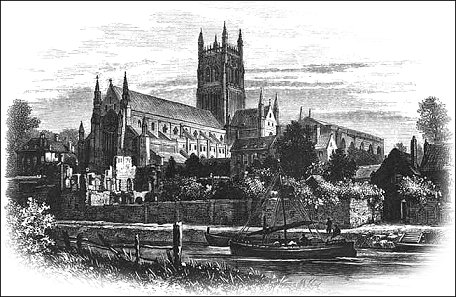Worcestershire Cathedral - Brief History and Regimental Connections
Situated on the River Severn opposite the county cricket ground, there has been a cathedral on this site in Worcester since 680 when Bishop Bosel was consecrated as the first bishop in that year. Nothing now remains of the first cathedral. However, the existing crypt of the cathedral does date from the 10th century and the time of Saint Oswald, then the Bishop of Worcester. The current cathedral, officially named The Cathedral Church of Christ and the Blessed Mary the Virgin of Worcester, dates from the 12th and 13th centuries. Bishop Oswald (c925 - 992) built a second abbey and monastery alongside Bishop Bosel's original cathedral.
 Monks and nuns had been present at the Cathedral since the seventh century. The monastery became Benedictine in the second half of the tenth century. The Benedictine monks were driven out in January 1540 and replaced by secular canons. The cathedral was subject to major restoration work by Sir George Gilbert Scott and A. E. Perkins in the 1860s (both men are buried at the cathedral).
Monks and nuns had been present at the Cathedral since the seventh century. The monastery became Benedictine in the second half of the tenth century. The Benedictine monks were driven out in January 1540 and replaced by secular canons. The cathedral was subject to major restoration work by Sir George Gilbert Scott and A. E. Perkins in the 1860s (both men are buried at the cathedral).
The Cathedral contains the tomb of King John in its chancel. Before his death in Newark in 1216, John had requested to be buried at Worcester. He is buried between the shrines of Saint Wulstan and Saint Oswald (now destroyed).
The Cathedral suffered great devastation during the Great Rebellion 1642-1659. beginning with Sunday, 25th September 1642, when the rebel soldiers under the Earl of Essex went to Church and with insult destroyed the Altars, Vestments, stained glass windows, and Organ—the Cathedral was derelict and the Divine Service silent till 31st August 1660.
The cathedral has a memorial, Prince Arthur's Chantry, to the young prince Arthur Tudor, who is buried there. Arthur's younger brother and next in line for the throne was Henry VIII. Worcester Cathedral was doubtless spared destruction by Henry VIII during the English Reformation because of his brother's Chantry in the cathedral.
Other famous burials at the cathedral include Prime Minister Stanley Baldwin (1867-1947), Bishop of Worcester John Gauden (1605-1662) and Richard Edes (d.1604), a Chaplain to Elizabeth I and James I.
Worcester was a strongly Royalist town and it was at Worcester 1651 that the New Model Army of Oliver Cromwell decisively won what proved to be the last battle of the English Civil War, against the largely Scottish Royalist forces assembled by Charles II.
Worcester Cathedral has long links with the Worcestershire Regiment. It was at the cathedral that the men who trained for war went to worship, there the Colours of the Regiment rested during the Regiment's absence on active service, and there those who returned went to offer thanksgiving.
Inside the Cathedral, in the West wall of the North Choir Transept, i.e. in the wall of the Chapel of St. George, looking down on the Altar is the wonderful "Memorial Window, to the Officers, Warrant Officers, Non-Commissioned Officers, and Men of the County and City of Worcester, and of The Worcestershire Regiment, who gave their Lives in the Great War." In this chapel you will find many memorials and tributes to the Worcestershire Regiment including the Colours of the different battalions hanging from the walls.
There are also a number of other Regimental tributes in the Cathedral, including;
A brass to the memory of Major-General Fitz-William Frederick Hunter, formerly of the 47th and 36th Regiments, who commanded the Worcester Regimental District for 5 years.
Monument erected by the Earl of Strafford to Officers, N.C.O.'s and Privates of the 29th (all of whose names are recorded) who fell on the Banks of the Sutlej.
Brass to the N.C.O.'s and Men of the 1st Battalion (late 29th) who fell in the South African War of 1899-1902, erected by Officers, N.C.O.'s and Men of the Battalion.
The Cathedral also holds books of remembrance containing the names of the the men of the Worcestershire Regiment who gave their lives during war.
